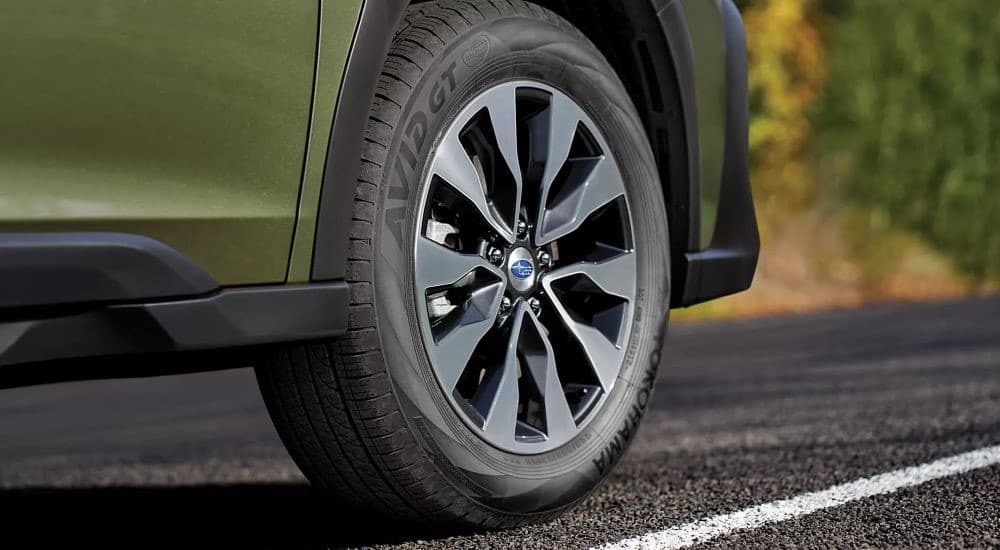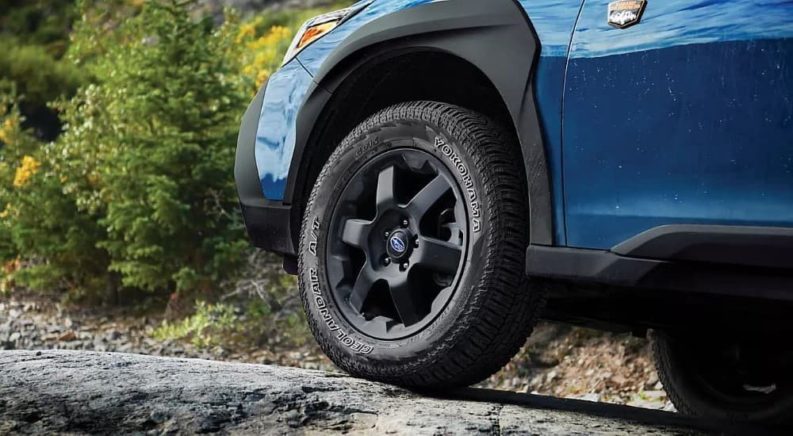If you go to a local dealership and find a Subaru Outback for sale, only a few types of tires will come standard on a new model. There’s some variation among the different trim levels, from the entry-level Base to the off-road-ready Wilderness to the high-tier Touring, but there won’t be a ton of variety. However, once it comes time to replace those tires, you can choose from a slew of brands, tire types, and sometimes even different sizes.
Of course, you need to be smart and make sure that the tires you’re getting are right for your particular model year and trim level. But many tire shops and dealership parts departments make it easy to enter your exact model and only browse options that will fit your car. The variety of choices can be overwhelming at first, but once you learn about the different types of tires and what each is best for, it shouldn’t be too hard to find a set of tires just right for your next adventure.
All-Season Tires
If you don’t have an off-road trim of the Outback and are looking for a good all-purpose tire for use on the road, you’ll probably want to go with a set of all-season tires. These tires are designed to provide a safe level of traction on both wet and dry roads, produce minimal noise, give you a comfortable ride, and last for a long time. Most Outback trims come standard with all-season tires, and if you like how they perform, you can easily get the same type when it comes time to replace them. As the old saying goes, if it ain’t broke, don’t fix it.
However, if you’re interested in trying something different, there are plenty of all-season tires that are compatible with the Outback. If you’re particularly sensitive to noise while driving, you could opt for a tire with noise-reduction technology, like the Dunlop Grandtrek ST30 or Hankook Optimo H426. If you often drive on rural roads and are afraid of getting stuck with a flat in an inconvenient place, then you could opt for a run-flat tire like the Bridgestone DriveGuard. These can continue to drive safely for a limited distance after they’ve been punctured, so you can get to a good place to repair or replace the tire.
While the name “all-season” implies that these tires can be used year-round, not all of them get good traction on snow-covered roads. However, there are some all-season tires that are rated for severe snow service. That means that the tires are able to deliver good traction on packed snow. To tell if a tire is severe snow service-rated, look for the “3 Peak Mountain Snowflake” emblem. All-season tires with this rating include Bridgestone WeatherPeak, Cooper Discoverer EnduraMax, and Firestone WeatherGrip. While these tires can hold their own in packed snow, it’s important to remember they won’t provide the same level of winter traction as dedicated winter tires, especially if you’re dealing with heavy snow and icy roads.

All-Terrain Tires
Heading off-road doesn’t just require dedicated equipment built into the body of a vehicle, like a lifted suspension and skid plates. It’s also important to have a set of tires that can handle a variety of terrain types and provide traction when the trail gets rough. These tires typically have deeper tread patterns, improving their performance in mud.
The benefit of all-terrain tires is obvious and priceless if you’re a fan of off-roading. But they do have a few drawbacks that you should be aware of. For one thing, since they’re designed for off-road surfaces, they sacrifice a certain level of comfort and quiet on smooth, paved surfaces. The deeper tread pattern can also cause them to wear down more quickly, so you’ll need to get them rotated regularly and replace them promptly when they’ve worn down too much.
Each all-terrain tire is different, so keep that in mind while shopping. Some tires are highly specialized for specific terrains, like mud, while others strive to be as well-rounded as possible. If you hit the trails every weekend, you may not be as concerned with on-road manners as a driver who uses their Outback for their daily commute and only ventures off-road a few times a year. There are plenty of capable options, so it shouldn’t be too difficult to find a tire that’s perfect for your needs.
The Outback’s off-road trim, the Wilderness, comes standard with all-terrain tires, and if you’re planning on hitting your local OHV trail, you should definitely stick with all-terrain tires when it comes time to replace them. As with all-season tires, you can find some all-terrain tires that are severe snow service rated, like the Yokohama Geolandar A/T G015, BFGoodrich Trail-Terrain T/A, and Goodyear Wrangler Workhorse AT.
Winter Tires
If you live somewhere with harsh winters, where temperatures are either near or below freezing for a large part of the year, switching to a set of dedicated winter tires when the cold season arrives is best practice. You may think that a Subaru with Symmetrical AWD can handle ice and snow even without winter tires, but remember that your tires are your vehicle’s only points of contact with the road. No matter how well-engineered your Outback is, the traction you get will depend heavily on what type of tires you have.
Winter tires have different tread patterns than all-season or all-terrain tires and are designed for getting a good grip in slush and snow. They’re also constructed with rubber compounds formulated to remain flexible in below-zero temperatures. However, note that this means they’ll wear down quickly if you forget to switch them out once spring arrives. Winter tires should only be used during the winter, not left on when the weather gets warm.
There are plenty of winter tires that are compatible with a Subaru Outback. The Bridgestone Blizzak DM-V2, Continental VikingContact 7, Michelin X-ICE Snow, and Yokohama iceGUARD G075 are good studless options. A studded tire like the Nokian Hakkapeliitta 10 is your best bet for maximum grip on ice. While studs enhance your grip on icy surfaces, they can also cause damage to roads, which is why there are some areas where studded tires can only be used during certain times of the year or are prohibited altogether. Be sure to check the legal situation in your area before opting for studded tires.

Some Final Thoughts
Whatever type of tire you decide to go with, make sure that it can fit your Outback before you commit to your purchase. Tires are available in multiple sizes, so you must ensure you get the right one. If you’re getting your tires directly from a Subaru dealership, you should be able to simply let them know what model year and trim level your Outback is, and they’ll make sure that you don’t get stuck with a set of tires you can’t use.
Once you’ve made your purchase, remember to take good care of your tires. Keep the air pressure within the recommended PSI range, get them rotated regularly to prevent uneven wear, and replace them once they’ve worn down too much. If you get the right tire for the type of driving you do and keep up with regular maintenance, then you’re sure to be in good shape for many miles to come.

